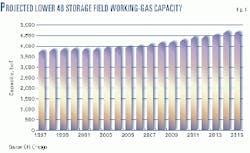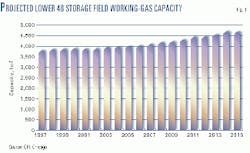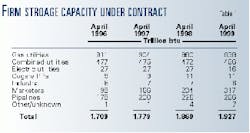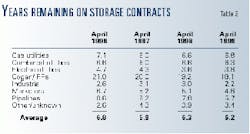Regulatory changes and steady growth in US natural gas consumption will trigger a 21% increase in gas-storage capacity over the next 15 years with a $5 billion investment, according to a new study from the Gas Research Institute, Chicago.
The study estimates that Lower 48 storage capacity for working gas will grow to 4.6 tcf in 2015 from 3.8 tcf in 1998 (Fig. 1). About 75% of the capacity additions are expected to occur after 2005 as gas demand grows more rapidly than storage capacity requirements during the next 5 years.
Part of the new capacity will provide storage operators with increased operating flexibility and augment changing needs of the power generation and industrial sectors, says the study.
These two sectors will account for nearly 80% of growth in gas consumption between 1998 and 2015. GRI projects the nation's gas demand will increase 50%, to 32.8 tcf in 2015 from 21.3 tcf in 1998.
The added storage capacity will require a gas-industry investment of nearly $5 billion (1998 $) between 1998 and 2015, or about $270 million/year, according to study estimates.
Trends
The study, conducted for GRI by Energy and Environmental Analysis Inc., Arlington, Va., identifies several trends that will drive future storage requirements:
- High consumption by power generation and industrial markets will dampen seasonal volatility.
Because these sectors have relatively flat year-round load profiles, they act to complement rather than stimulate short-term demand swings in traditional residential and commercial applications that drive the need for increased storage capacity to overcome seasonal differences.
- Increases will occur in the value of market-area storage to accommodate significant growth in gas use for power generation.
Due to improvements in technology, favorable economics, and low emissions, says the study, natural gas will be the preferred incremental fuel for power generation.
- Pipeline restructuring is changing the role and value of storage.
Most notable are the development of secondary markets for storage and pipeline capacity, growth of market hubs and gas marketers, and a shift toward market-based rates.
- Storage services will become more efficient as a result of local distribution company restructuring.
Storage operators, says the study, will have a direct profit motive to maximize the value of storage and are likely to offer new services that use existing facilities more effectively.
John Cochener, GRI project manager and principal analyst-resource evaluation, said that increases were already apparent in the value of well-placed storage facilities, particularly those able to capitalize on regulatory changes that allow for greater operating flexibility.
"The reduction in regulatory constraints will allow storage market players even greater latitude in the future to experiment with innovative competitive tools. This will result in greater flexibility in the timely movements of gas to where it's required," said Cochener.
"Conversely, high-cost storage operators, who fail to respond to the changing market, may eventually find themselves at a competitive disadvantage in the future and see the value of their storage asset stagnate," he said.
Coverage
GRI says the study is its most comprehensive look at gas storage markets.
It includes an analysis of changes in storage capacity, services, customer-use patterns (Table 1) and costs, and proposed storage projects. The study also covers LNG and propane-air along with traditional storage facilities.
The study also reviews future storage requirements, costs associated with expanding different types of storage capacity, and the merits of different storage locations.
Also examined is storage capacity under existing contracts. One finding is that the average length of time until contract expiration for firm storage contracts has declined to 6.2 years in 1999 from 6.8 years in 1996 (Table 2).
More than half of the existing contracts in spring 1999 will expire by 2004, says the study. By 2006, 70% of existing contracts will have expired.
Moreover, storage operators will generally be replacing storage contracts negotiated by local distribution companies (with guaranteed rates of return) with contracts negotiated by the growing ranks of gas marketers, who are under competitive pressure to hold down costs.
The number of years remaining under existing storage contracts varies by customer type, according to the study. Currently, cogenerators and independent power producers have the longest remaining contract lengths, followed by pipelines, gas utilities and marketers.
Electric utilities, and industrial customers have the shortest average contract lengths remaining.
The study lists the top 50 storage-capacity holders.





